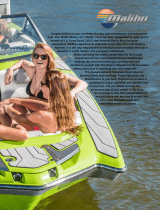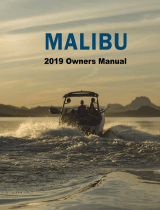
Inspect all equipment prior to each use, check
bindings, fins, tube, attachment, tow rope and flotation
device. Do not use if damaged.
Watercraft Safety: A knowledgeable and responsible driver is
the most important safety device on any watercraft.
Never operate a watercraft, ski or ride under the
influence of alcohol or drugs.
Only use water ballast and people for additional
weight.
Never exceed the passenger or weight limitations of
the watercraft.
Never allow passengers to hang outside the watercraft
or towed device or sit on the gunwales or anywhere
outside of the normal seating area.
Never allow water to overflow the bow or gunwales of
the watercraft.
Uneven weight distribution or additional weight may
affect the handling of the watercraft.
Carbon Monoxide: The exhaust from the engine on a watercraft
contains Carbon Monoxide (CO) which is a colorless, odorless
and poisonous gas. Excessive exposure to CO can cause severe
injury or death. Follow this advice to avoid injury.
Never “Platform Drag” by holding onto the boarding
platform or be dragged directly behind the watercraft.
This is where CO will be.
Do not sit on the watercraft transom or boarding
platform while the engine is running.
Make sure the engine is properly tuned and running
well. An improperly tuned engine produces excessive
exhaust and CO.
If you smell engine exhaust do not stay in that
position.
Go to the United States Coast Guard’s website:
www.uscgboating.org for more information on how to
help protect yourself and others from the dangers of
CO.
Tow Ropes: Tow ropes come in different lengths and strengths
for different activities. Make sure any rope you are using is suited
for skiing or riding and that it is in good condition.
Never use a rope that is frayed, knotted, unraveling or
discolored from use or being left in the sun. If a rope
breaks while in use it can recoil at the skier/rider being
towed or into the watercraft where it might strike
passengers. Replace tow ropes with any sign of
damage.
Never use a tow rope with elastic or bungee material to
pull skiers or riders.
Rope should be attached to the watercraft in an
approved fashion with hardware designed for towing.
Refer to your watercraft manual for instructions on
proper tow rope attachment.
Always keep people and tow ropes away from the
propeller, even when idling.
If a tow rope should become entangled in a propeller,
shut off engine, remove the key and put it in your
pocket before retrieving the rope.
Tow ropes should be neatly stowed in the boat when
not in use.
Preparing to ski or ride: Always have a person other than the
driver as an observer to look out for the skier/rider.
Be sure the driver is aware of the experience and
ability level of the skier/rider.
The driver, observer and skier/ rider need to agree on
hand signals before skiing or riding. Signals should
include READY, STOP, SPEED UP, and SLOW
DOWN.
Start the engine only after making sure that no one in
the water is near the propeller.
Turn the engine off when people are getting into or
out of the watercraft, or in the water near the
watercraft.
Always make sure the tow rope is not wrapped around
anyone’s hands, arms, legs, or other parts of the body.
Start the watercraft and move slowly to remove slack
until the tow rope is tight.
When the skier/rider signals READY and there is no
traffic ahead, take off in a straight line. Adjust the
speed according to the signals given by the skier/rider.
Skiing or Riding: The watercraft and skier/rider should always
maintain a sufficient distance from obstacles so a skier/rider










